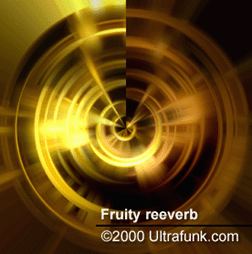
VST plugins for
FruityLoops
Fruity reeverb
 |
VST plugins for |
 Fruity reeverb implements a high-quality diffuse reverberation algorithm.
Fruity reeverb implements a high-quality diffuse reverberation algorithm.
Fruity reeverb is a FruityLoops-exclusive VST plugin, based on fx:reverb, a part of Ultrafunk's Sonitus:fx DirectShow audio plug-in package. Other plug-ins included in the pack is fx:equalizer, fx:modulator and fx:phase.
More information on Sonitus:fx plug-ins can be found at http://www.ultrafunk.com/products/sonitusfx/
 Low Cut
Low Cut
Adjusts the low cutoff frequency. Use this to remove low frequencies from the input signal before reverb
is added. For example, if you are adding reverb to, say a drum track, you might want to remove some of
the 'rumble' from the bass drum by attenuating the bass frequencies.
Setting this parameter to the minimum value will bypass the Low Cut filter, displaying OFF in the value field.
Range: OFF, 20 to 3000 Hz
High Cut
Similar to the Low Cut, this adjusts the high cutoff frequency. Use this to remove high frequencies from
the input signal.
Setting this parameter to the maximum value will bypass the High Cut filter, displaying OFF in the value field.
Range: 0.5 to 22.0 kHz, OFF
Predelay
Controls the delay time between the direct input signal and the first reverb reflection. This should be
set to modest values for small rooms, and can be increased in relation to increases in room size. Predelay
creates a slap-back echo effect that can both add atmosphere and muffle the signal, so use it wisely.
Range: 0 to 250 milliseconds
Room Size
Use this to set the size of the virtual room where the reverb is created. The Room Size should be adjusted
according to the decay time. Small rooms sound better with a short decay time, large rooms sound better
with longer reverb times.
Range: 1 to 100 (relative size, no specific unit used)
Diffusion
Controls the density of the reflections bouncing off the walls of the virtual room. A low diffusion setting
makes the reflections sound more distinct, like closely spaced echos. A high diffusion setting creates
reflections so close they sound more like white noise, where no echos can be distinguished.
Range: 0 to 100 %
Color
The Color parameter is used for adjusting the decay time of the bass frequencies of the signal. This
allows you to change the overall perceived mood or 'sound' of the virtual room. A bright room has
a low bass response, while warm rooms have a higher bass response. In a flat room, the response of
the bass is equal to the general frequency response.
Color has five settings: Brighter, Bright, Flat, Warm, Warmer.
Decay
Controls the decay time of the reverb, the time it takes for the signal to decay to -60dB (1/1000 of
the maximum amplitude). Use low decay times for small rooms or boxes, and long decay times for large
rooms, halls or churches. You should also make sure that the Room Size parameter has an appropriate value.
Range: 0.1 to 20.0 seconds
High Damping
This parameter allows you to adjust damping of the high frequencies in the reverb signal over time.
Damping refers to the high frequencies being attenuated and dying out. This causes the sound to become
gradually muffled and warm like it is being absorbed in the room.
Setting this parameter to the maximum value will bypass the High Damping, displaying OFF in the value field.
Range: 0.5 to 20.0 kHz, OFF
Dry
Sets the relative dry output level.
Range: 0 to 100 %
Reverb
Sets the relative reverb (wet) signal level.
Range: 0 to 100 %